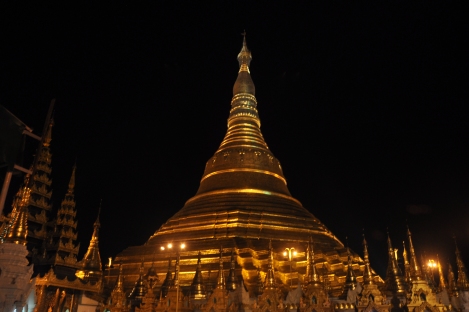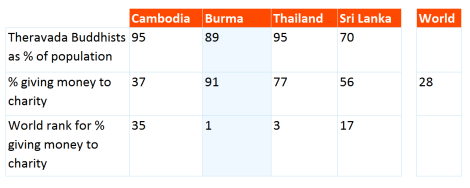The 2014 World Giving Index has found that a larger proportion of Burmese people give money
 to charity every month than any other country on earth – by far.
to charity every month than any other country on earth – by far.On November 18th, the Charities Aid Foundation (CAF) published the fifth edition of the worlds only global index of charitable activity which ranks nations based on the proportion of people who, according to Gallup’s World Poll, had given money
 to a charity, volunteered or helped a stranger in the past month.
Remarkably, this year Burma (Myanmar) shares first place with the United
States of America.
to a charity, volunteered or helped a stranger in the past month.
Remarkably, this year Burma (Myanmar) shares first place with the United
States of America.By taking into account volunteering and informal acts of kindness to strangers, the World Giving Index can build a picture of generosity that is less skewed by wealth than a study that merely looks at financial giving. Many developing and transitional economies have vibrant and long standing cultures of giving that would not be picked up by limiting the definition of charitable giving to the donation of money
 to a nonprofit organisation.
to a nonprofit organisation.Right about now you are probably thinking; “Ah okay, I get it. You are going to tell me that we are undervaluing the generosity of some countries by focusing on donations of money
 and then say that Burma is a shining example of this, right? Well, I do
think that we undervalue informal giving as it provides the fertile
ground on which civil society can grow, but with regards to Burma, you
are totally wrong.
and then say that Burma is a shining example of this, right? Well, I do
think that we undervalue informal giving as it provides the fertile
ground on which civil society can grow, but with regards to Burma, you
are totally wrong.In terms of the proportion of people giving money
 to charity, Burma is peerless. 91% of Burmese people said that they had given money
to charity, Burma is peerless. 91% of Burmese people said that they had given money to charity in the month prior to being surveyed – a clear 13 percentage
points ahead of Malta in second place for that measure. The USA ties
with Burma overall due to high rates of people who said that they had
helped a stranger in the last month (79%). In fact, the USA ranks first
in the world on that measure and by virtue of being in the top ten for
the other two measure – 9th for giving money
to charity in the month prior to being surveyed – a clear 13 percentage
points ahead of Malta in second place for that measure. The USA ties
with Burma overall due to high rates of people who said that they had
helped a stranger in the last month (79%). In fact, the USA ranks first
in the world on that measure and by virtue of being in the top ten for
the other two measure – 9th for giving money (68%) and 5th for volunteering (44%) – gains a high enough overall score to share first place with Burma.
(68%) and 5th for volunteering (44%) – gains a high enough overall score to share first place with Burma.For a country with a human development index ranking (150th) to achieve such staggeringly high levels of participation in giving money
 challenges the perception that the propensity to donate money is
necessarily tied to wealth. Moreover, its high placing despite a recent
history of violence and oppression seems to contravene the idea that
civil society can only thrive when government helps to nurture an
enabling environment.
challenges the perception that the propensity to donate money is
necessarily tied to wealth. Moreover, its high placing despite a recent
history of violence and oppression seems to contravene the idea that
civil society can only thrive when government helps to nurture an
enabling environment.So what explains such high levels of engagement in charitable giving in Burma?
Theravada is one of the oldest schools of Buddhism and traces its origins back to Buddha’s 2500 year old teachings. In Theravada, peace and freedom are pursued internally rather than externally through a life of meditation by a community of ordained monks and nuns called the Sangha. Their lifestyle is supported by lay devotees through charitable giving: Sangha Dana. In Burma 5% of the population live monastic lives which are entirely funded by donations from the remaining 88% of the population who are lay devotees of Theravada Buddhism. It seems highly likely that this religious tradition explains why Burma tops the World Giving Index for donating money.
Indeed, countries in which a high proportion of the population follow the Theravada school of Buddhism feature prominently in this year’s World Giving Index, particularly in terms of the percentage of people giving money to charity.
Four of the five countries with the highest proportion of Theravada Buddhists – Burma, Sri Lanka, Thailand and Cambodia – are covered by the 2014 World Giving Index (no data is available for Laos). All four countries are in the top 35 nations in terms of giving money to charity out of 135 nations covered in this years index. Burma and Thailand are ranked first and third respectively for donating money.
Some people may question whether religious convention that permeates culture as strongly as Sangha Dana in Burma should be seen as charitable giving at all. It could be argued that donations are essentially a voluntary taxation in return for the myriad services and amenities provided by monks and nuns. However, attempting to make such a distinction would be as impossible in Burma as it is in any other country.
Some people may hold Burma up as an example of how mass engagement in giving can triumph in spite of adverse conditions. This narrative clearly has some merit and we would do well to remind ourselves of the existing human resources in civil society in the developing world and the potential for ordinary people to help each other. This view is supported strongly by the high proportion of people indicating that they had helped a stranger in some of the world’s most troubled nations in the 2014 World Giving Index. However, for civil society to make real social gains governments must be tolerant of and responsive to the advocacy of not-for-profit organisations. Only time will tell as to whether the Burmese government can improve on this measure.
The example of Burma helps to challenge any preconceptions we might have about charitable giving. and is therefore a useful reminder of the different models that civil society takes around the world. As always, I welcome other interoperations of these findings and encourage you to share your views.
Adam Pickering
http://futureworldgiving.org/2014/11/19/burma-leads-the-world-in-people-giving-money-to-charity/




Comments